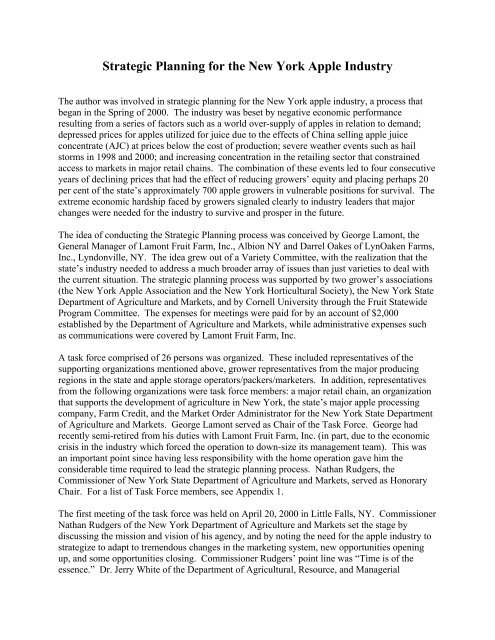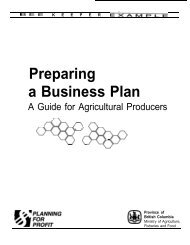Gerald B. White - Agricultural Marketing
Gerald B. White - Agricultural Marketing
Gerald B. White - Agricultural Marketing
Create successful ePaper yourself
Turn your PDF publications into a flip-book with our unique Google optimized e-Paper software.
Strategic Planning for the New York Apple Industry<br />
The author was involved in strategic planning for the New York apple industry, a process that<br />
began in the Spring of 2000. The industry was beset by negative economic performance<br />
resulting from a series of factors such as a world over-supply of apples in relation to demand;<br />
depressed prices for apples utilized for juice due to the effects of China selling apple juice<br />
concentrate (AJC) at prices below the cost of production; severe weather events such as hail<br />
storms in 1998 and 2000; and increasing concentration in the retailing sector that constrained<br />
access to markets in major retail chains. The combination of these events led to four consecutive<br />
years of declining prices that had the effect of reducing growers’ equity and placing perhaps 20<br />
per cent of the state’s approximately 700 apple growers in vulnerable positions for survival. The<br />
extreme economic hardship faced by growers signaled clearly to industry leaders that major<br />
changes were needed for the industry to survive and prosper in the future.<br />
The idea of conducting the Strategic Planning process was conceived by George Lamont, the<br />
General Manager of Lamont Fruit Farm, Inc., Albion NY and Darrel Oakes of LynOaken Farms,<br />
Inc., Lyndonville, NY. The idea grew out of a Variety Committee, with the realization that the<br />
state’s industry needed to address a much broader array of issues than just varieties to deal with<br />
the current situation. The strategic planning process was supported by two grower’s associations<br />
(the New York Apple Association and the New York Horticultural Society), the New York State<br />
Department of Agriculture and Markets, and by Cornell University through the Fruit Statewide<br />
Program Committee. The expenses for meetings were paid for by an account of $2,000<br />
established by the Department of Agriculture and Markets, while administrative expenses such<br />
as communications were covered by Lamont Fruit Farm, Inc.<br />
A task force comprised of 26 persons was organized. These included representatives of the<br />
supporting organizations mentioned above, grower representatives from the major producing<br />
regions in the state and apple storage operators/packers/marketers. In addition, representatives<br />
from the following organizations were task force members: a major retail chain, an organization<br />
that supports the development of agriculture in New York, the state’s major apple processing<br />
company, Farm Credit, and the Market Order Administrator for the New York State Department<br />
of Agriculture and Markets. George Lamont served as Chair of the Task Force. George had<br />
recently semi-retired from his duties with Lamont Fruit Farm, Inc. (in part, due to the economic<br />
crisis in the industry which forced the operation to down-size its management team). This was<br />
an important point since having less responsibility with the home operation gave him the<br />
considerable time required to lead the strategic planning process. Nathan Rudgers, the<br />
Commissioner of New York State Department of Agriculture and Markets, served as Honorary<br />
Chair. For a list of Task Force members, see Appendix 1.<br />
The first meeting of the task force was held on April 20, 2000 in Little Falls, NY. Commissioner<br />
Nathan Rudgers of the New York Department of Agriculture and Markets set the stage by<br />
discussing the mission and vision of his agency, and by noting the need for the apple industry to<br />
strategize to adapt to tremendous changes in the marketing system, new opportunities opening<br />
up, and some opportunities closing. Commissioner Rudgers’ point line was “Time is of the<br />
essence.” Dr. Jerry <strong>White</strong> of the Department of <strong>Agricultural</strong>, Resource, and Managerial




